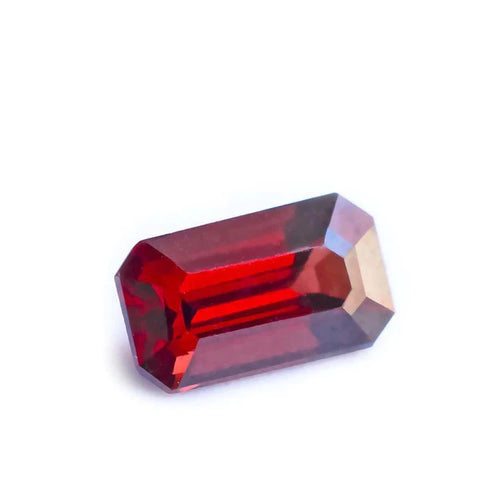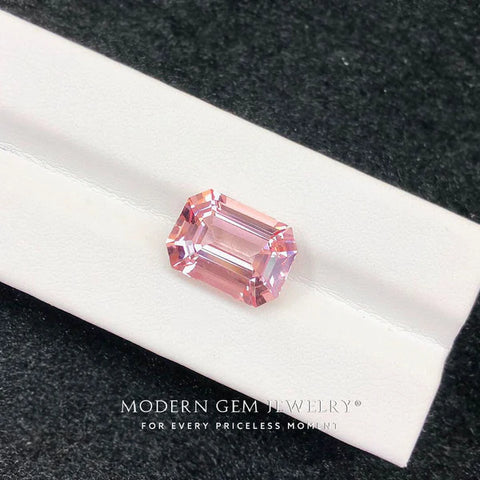Originally intended exclusively for the emerald stone (hence the name), this cut is one of the oldest diamond shapes dating back all the way to the 16th century. It is a rectangular cut with elongated facets and trimmed edges. Emerald cut gemstones are known and cherished for their appeal and elegance with their clean lines and rich history. Why is this particular cut revered in the gemstone world? This comprehensive guide answers that by helping you identify high-quality emerald-cut gemstones, covering all the key factors including symmetry, pricing and historical significance.
Emerald Cut Clarity and Color:
Clarity refers to the presence of any internal flaws known as inclusions in a gemstone while color pertains to the saturation of the stone. Clarity is a very important factor in determining the value of emerald cut gemstones. A stone with fewer inclusions is higher in value and will command higher prices in the market. Similarly, the desirability and marketability of emerald cut gemstones heavily relies on their color. Stones with excellent saturation and few secondary tones are more sought after.
Evaluating Carat Weight in Emerald Cuts:
Another consideration when assessing the quality of an emerald cut gemstone is its carat weight. The bigger the carat, the heavier the stone. The carat weight contributes to the overall size and presence of the stone and it is important to strike a good balance between your preferred carat weight and other factors. This is because a larger carat weight does not necessarily mean a more valuable gemstone; the other factors also play relevant roles in deciding the value of an emerald cut stone.
Certification and Grading Standards
One of the most important parts of the jewelry purchase process is quality assurance. An emerald-cut gemstone is an investment and during purchase, it is important to ensure the stone is certified by a credible gemological lab. That provides assurance regarding the authenticity of the gemstone thereby helping you make an informed decision.
Gemstone Certification for Emerald Cuts:
A certified emerald cut gemstone will go through an extensive assessment by experienced gemologists. The report will provide very detailed information about the gemstone’s characteristics. Reputable gem laboratories such as the Gemological Institute of America (GIA) and the Asian Institute of Gemological Sciences (AIGS) are some of the most trusted sources for gemstone certification.
GIA Grading for Emerald Cut Stones:
The GIA grading system is widely known in the jewelry industry and provides a system for assessing emerald cut gemstones. On a GIA report, you would find the information on its carat weight, color grade, clarity grade, its cut grade, measurements and proportions and its fluorescence. It will also include any additional information such as a plot drawing showing the stone’s internal and external features or any treatments the gemstone may have undergone.
Assessing Symmetry and Proportion
Another factor to consider is to properly assess symmetry and proportion. These critical aspects of the cut quality of a gemstone are sometimes overlooked, however there is nothing that can replace the beauty and allure of a well-proportioned stone.
Symmetry and Proportion in High-Quality Emeralds:
Let us explain these terms. First, symmetry is the balance of the facets of the gemstones while proportion has to do with the relationships between the length and width of the gemstone.
A well-proportioned stone with symmetrical facets will exhibit optimal brilliance and fire making it a lot more desirable and beautiful. Furthermore, stones of that nature will also have a uniform distribution of light. Conversely, emerald-cut stones with bad symmetry and uneven proportion will look dull and lifeless.
Spotting Inclusions in Emerald Cuts:
We previously explained inclusions as the natural, internal blemishes a gemstone has that can influence its clarity. Due to the large, open facets and step cut faceting of emerald cut gemstones, inclusions may be more visible. During the evaluation process before purchase, inspect the stone thoroughly for any inclusions because stones having less inclusions are higher in quality and will command a higher price. The kinds of inclusions to look out for include cloudiness, internal shattering and mineral crystals within the stone. While minor imperfections may be acceptable, significant flaws or damage can significantly affect the stone's desirability and price. It is important to note that some inclusions are visible to the naked eye while some require magnification to be detected.
Factors Affecting Pricing
The pricing of emerald cut gemstones depends on several of the aforementioned factors including market trends. Understanding these factors can help you as a buyer properly gauge not only its value but also its investment potential.
Emerald Cut Gemstone Pricing Guide:
In addition to the 4C’s, the price of emerald cut gemstones is influenced by market demand and supply and consumer preferences. Stones that are rare and highly sought-after will fetch premium prices in the market.
Comparing Emerald Cuts vs. Other Gemstone Cuts
It is well established at this point that emerald cut gemstones have their own unique charm, however they may not be the exact choice for every occasion and the preference of every shopper. There are other popular gemstone cuts including the cushion cut, the very famous round brilliant and the princess cut among others and these cuts all have their individual appeal. Consider the pros and cons of each cut when making a decision.
The History of the Emerald Cut Design:
The emerald cut gained appeal and popularity during the Art Deco era of the 1920’s and 1930’s when linear patterns and geometric shapes were in demand. Its design dates back to the 16th century and is believed to have originated in India. All these years later, the emerald cut is still a classic choice for fine and high jewelry due to its understated charm.
Selecting the Right Setting for Emerald Cut Gemstones:
Bear in mind at all times the size, color and shape of the stone but especially when picking out a setting for your emerald cut gemstone. Solitaire, three-stone and halo designs are top, classic choices when it comes to the emerald cut. You can also defy tradition by going for contemporary settings like the bezel or the tension set and put your own spin on your piece to reflect your personal style.
So, it is apparent these beautiful gems hold their own in terms in allure and charm. From their rich history, impeccable craftsmanship and their versatility, they stand out as symbols of elegance and refined taste. So whether you are wearing a captivating engagement ring or a statement necklace, these gemstones keep capturing hearts and continue to awe-inspire. Make all the informed decisions you can with the tips in this guide and appreciate the beauty of emerald cut gemstones.
If you seek to create a valuable addition to your jewelry collection or create your perfect symbol of love, Saratti is your stop. We specialize in handcrafting exquisite jewelry pieces that feature emerald cut gemstones. With our expertise, each piece will exude all the charm with unbeatable quality.







